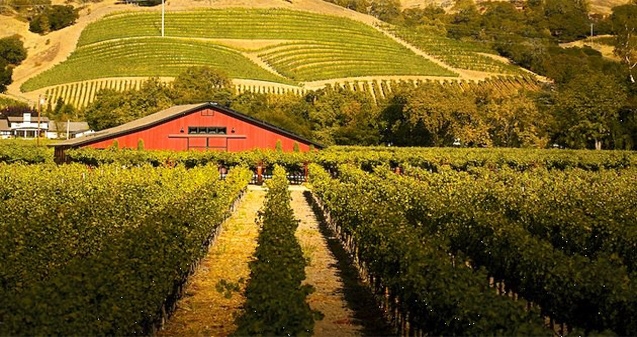
My first trip to Napa Valley was in the late 1960s, during my senior year at U.C. Berkeley. I had just turned 21, and here was this amazing place only an hour's drive away with rolling blond hills and the sunny climate of Provence, where you could spend a leisurely afternoon sipping for free at Inglenook, Beringer, and Mondavi.
Four decades and a dozen visits later, I still find myself drawn here. Maybe it’s the pastoral beauty of the Silverado Trail, which twists its way past acres of vineyards and those unchanging blond hills. Or the small-town charm of St. Helena's Main Street and its one-of-a-kind shops. Or the fact that the farm-to-table movement has never waned and continues to influence the next generation of Napa chefs. This makes it one of the most dynamic food destinations in the country. Here, a peek into my little black book.
Where to Stay
Restaurateur Claude Rouas brought Provençal style to Napa in 1981 with Auberge du Soleil, his tiny French bistro on the hills above Rutherford. I remember every bite of my first lunch there a month after it opened—the homemade pâté, the salade niçoise, the tarte au citron. A few years on, 52 sun-splashed guest rooms were added. Today, the hotel is no less stylish, drawing a mix of Hollywood types and couples getting away from it all, and its newest addition, Maison Saint-Tropez, offers eight romantic, earth-toned suites (hand-carved oak headboards; outdoor tubs).
Not to be outdone, Auberge’s sister property, Calistoga Ranch—a woodsy, 157-acre retreat set in a canyon off the Silverado Trail—just had a refresh. Enhancements include a separate pool catering to families (unlike Auberge, Calistoga allows kids under 16), five creekside spa pavilions, and green touches such as LED lighting. In the 48 cedar lodges, there are now iPads in the rooms and sculptures in the outdoor showers.
A few miles north, Solage Calistoga, also part of the Auberge collection, stays true to its setting (the town’s hot springs are legendary) with a 20,000-square-foot spa. Book the signature “mudslide,” which includes a scrub and mineral-water soak in a claw-foot tub; afterward, you can zone out in a zero-gravity chair. Thanks to a recent makeover, the 89 studios have a softer feel (silver-toned carpets instead of concrete floors), and everyone is raving about chef Brandon Sharp’s six-year-old Solbar. Don’t miss his chilled ambrosia melon soup and confit of Niman Ranch lamb shoulder.
One of my first Napa experiences was a stay at Yountville’s Magnolia Inn, which has now been reimagined as Maison Fleurie, a collection of 13 warm but simple French-inspired rooms in three vine-covered stone buildings. The rates are wildly affordable—as low as $150 a night for the smallest room during harvest season. Just across the street is the LEED Platinum–certified Bardessono Hotel & Spa, where the 62 rooms offer a less-is-more aesthetic (organic linens; bay laurel-wood desks), except for the bathrooms, which are big enough to actually fit a massage table.
Also in town is the year-and-a-half-old North Block Hotel, the work of St. Helena-based interior designer Erin Martin. The 20 modern rooms are scattered around a lemon-tree-filled courtyard, where you’ll also see people popping in to Richard Reddington’s on-site pizzeria, Redd Wood. Set on a bluff above Yountville and owned by the founder of Cliff Lede Vineyards, the Poetry Inn is that upscale B&B you’re always looking for: five contemporary rooms, all with fireplaces, none with shared walls, so you won’t hear your neighbors. The innkeepers—Leona McLaughlin, Henrike Wagner, and Bob Copeland—can help with special requests; they once set up a private dinner for 10 at the French Laundry with only a week’s notice.
The Andaz brand has continued to expand, with the opening of its hotel in downtown Napa last year: think 141 clean-lined rooms with decadent marble tubs and a buzzy terrace with fire pits and porch swings. For the full resort experience, try Meadowood, a 250-acre spread of 85 suites and cottages on the outskirts of St. Helena. The vibe is understated country club; guests wear whites for croquet and walk the nine-hole golf course. The 44-seat, Michelin three-starred Restaurant at Meadowood, run by the brilliant chef Christopher Kostow, opened an expanded bar area with an exclusive menu in March. The nine-course tasting is $450 a head, with wine pairings—and is worth every penny.
Where to Eat
Back in the day, there weren’t many restaurants to pick from in Yountville. Then came Don and Sally Schmitt’s French Laundry in 1978. Now, it’s hard to choose where to go. There’s Michael Chiarello’s tried-and-true Italian spot, Bottega, and Richard Reddington’s Redd, plus three from Thomas Keller: Bouchon, a French bistro, Ad Hoc, which draws in the winemakers, and the Michelin three-starred French Laundry (he took it over from the Schmitts in 1994). Even if you don’t have a reservation at the latter, you can tour Keller’s nearby garden, where he grows Tuscan kale and winter squash.
While Yountville has been known for the classic star-chef restaurants, St. Helena has always felt hipper, with more relaxed places. On a recent visit I enjoyed French Blue, an airy, light-filled New American spot on Main Street designed and owned by local architect Howard Backen. Chef Philip Wang sources whatever he can locally, like the berries from a farm just up the road that appear in everything from the baked blueberry pancake at breakfast to the strawberry shortcake at dinner.
At lunchtime, you’ll see locals crowding the tables for plates of fettucine with pesto broth and Calabrian chiles at Cook St. Helena, a tiny space with a marble-topped bar. La Condesa, a low-key cantina, churns out Tecate-battered shrimp tacos and exotic ice creams (avocado coconut curry; honey rosemary); plus, there are some 200 tequilas and 30 mezcals at the bar. (But who’s counting?) The trendy Goose & Gander gives a nod to the current cocktail craze. The upstairs dining room recalls an old hunting lodge, with its duck decoys and leather booths; the downstairs bar evokes a speakeasy. Michael Pazdon and Scott Beattie craft drinks with hand-carved ice and 25 types of seasonal edible flowers—your Pimm’s Cup might get a gem-marigold garnish.
The town of Napa has always felt businesslike. But in recent years, the urban atmosphere has given way to a thriving restaurant and bar scene with the addition of Oenotri (hearty southern Italian), Angèle (fantastic French by the river—Auberge’s Rouas is a partner), Morimoto (sushi from the eponymous Iron Chef), ZuZu (delicious tapas), and the year-old Thomas & Fagiani’s Bar, set in a brick-walled former boardinghouse. Head to the roof deck for the lovely views of the Napa River and a rhubarb gimlet.
Napa is also a great place for lunch. Stop by any purveyor at the 40,000-square-foot Oxbow Public Market for a grab-and-go meal, though we’re certain you’ll want to sit for a dozen on the half shell at Hog Island Oyster Company. Gott’s Roadside, next door, is famous for burgers, or try Dim Sum Charlie’s food truck for pork shu mai out of a vintage Airstream. Don’t skip breakfast at Chef Curtis and Tara Lindley’s Southern-style bakery, Napa Valley Biscuits. The ambitious (or slightly hungover) tuck in to the “peppy”: fried chicken and bacon sandwiched between two waffles.
Where to Taste
I prefer wineries that offer more than just a pour, where you can hike or bike or see incredible art and architecture. Take the curving, Gaudiesque Quixote Winery in the Stag’s Leap District, north of Napa. Designed in the 1990s by the Austrian artist Friedensreich Hundertwasser, this golden-domed building only opened to the public in 2007; don’t miss their Petit Syrahs and Cabernets. Another must is the Hess Collection, which, in addition to having outstanding Cabernets and Chardonnays, showcases works by the likes of Robert Motherwell, Frank Stella, and Andy Goldsworthy in a 1903 stone winery. Michael Graves’s stunning, postmodern Minoan temple - the centerpiece of Clos Pegase Winery, outside Calistoga - features gigantic sculptures by Henry Moore, Jean Dubuffet, and Robert Morris on its grounds.
For something on a more intimate scale, there’s Stony Hill Vineyard: 160 heart-stopping acres on the slope of Spring Mountain, north of St. Helena. Call ahead to book a guided hour-long hike with Sarah McCrea, granddaughter of the founders: for $100 per person, this includes a picnic lunch by redwoods and pours of Chardonnay. Go to Swanson Vineyards as much for the elegant but quirky atmosphere (you’re seated in a carnival-like, cherry-red salon) as for the Cabernets.
One to watch: the new tasting room and culinary center by Jarred Denton and Signum Architecture for Hall Wines in St. Helena. When finished, it promises to be a marvel of floor-to-ceiling glass windows, with views of the sheltered St. Helena valley floor. Also on the horizon is Odette Estate Winery, from former San Francisco mayor Gavin Newsom, Gordon Getty and John Conover (the trio behind PlumpJack Winery and CADE). When completed next year, the project—set on 36 acres off the Silverado Trail—will feature 18,000 square feet of caves, solar panels, and a planted living roof designed by Mexican architect Juancarlos Fernandez. Though Odette’s first vintage won’t be out until 2015, the estate has a temporary tasting room where you can sample other bottles.
If you’re a collector, get in touch with wine experts David and Monica Stevens. The couple own 750 Wines, a St. Helena store stocking the best labels, and they host tastings by appointment with lesser-knowns like Dakota Shy and Pulido Walker, up-and-comers like Matthiasson and established names like Harlan and Bond.
Where to Shop
You don’t really come to Napa for the shopping, but if you must, St. Helena is the place. Browse Pennyweight for stationery, fountain pens, and colorful Pasotti umbrellas; Flats for gorgeous cashmere scarves from India and ballet shoes made in Florence; and St. Helena Olive Oil Company, housed in a former bank, for locally pressed extra-virgin oils. The Culinary Institute of America sells everything you could ever imagine for the kitchen. Woodhouse Chocolate is a gem of a store with butter-colored, wood-paneled walls. Their s’mores (dipped in Belgian milk chocolate) and whole bars topped with smoked paprika and saffron salt are to die for.








